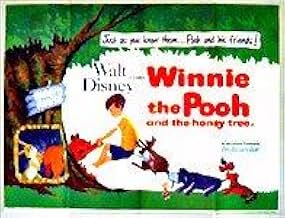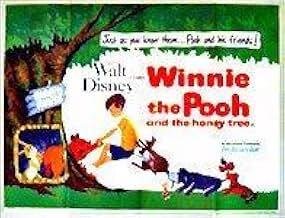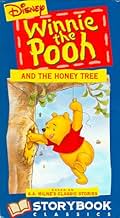CALIFICACIÓN DE IMDb
8.0/10
5 k
TU CALIFICACIÓN
El oso de Christopher Robin intenta asaltar una colmena en un árbol alto.El oso de Christopher Robin intenta asaltar una colmena en un árbol alto.El oso de Christopher Robin intenta asaltar una colmena en un árbol alto.
- Dirección
- Guionistas
- Elenco
- Premios
- 1 nominación en total
Ralph Wright
- Eeyore
- (voz)
Barbara Luddy
- Kanga
- (voz)
Howard Morris
- Gopher
- (voz)
Clint Howard
- Roo
- (voz)
James MacDonald
- Bees
- (voz)
- (sin créditos)
Dal McKennon
- Bees
- (voz)
- (sin créditos)
Thurl Ravenscroft
- Bass Vocals
- (voz)
- (sin créditos)
Ginny Tyler
- Bees
- (voz)
- (sin créditos)
Opiniones destacadas
Like the other three Pooh shorts that made up the feature film of the Many Adventures released in 1977 and on video in the 80s, the Honey Tree short was one of those works I've watched countless times. It does have its 'valuable lesson' for the kids, but it's also just very silly, cute entertainment that ranges from jokes so absurd they work for some adults ("You messed up my moose" is a line I still quote today, the Gopher material is also rather off-key for a children's short), to the suspenseful moments that, for lack of a better description, capture kid's imaginations. And the whole structure of it being a book-as-animated short give it an inventiveness that don't come with other adaptations of books to Disney animation. Here, Rabbit becomes irate and near impatient as Pooh gets stuck in his rabbit-hole after consuming more honey than needed. Pooh then is stuck for a week until he can loose the excess baggage, where a very climactic and momentous pull of Pooh is lead in song and action. All of this is very clever, and even for little kids its got nothing at all complicated about it- even if all the points and little jokes aren't caught the thrust of the storytelling and joyous nature even in the safer moments are near-perfect. And unlike what apparently is meant for current pre-K programming today (Teletubbies aren't on anymore at least), the whole mood is very pure without being pandering. There's no overt vulgarity, and the over-the-top moments don't get old ("Don't feed the bear" is another quotable phrase). Highly recommended.
The "Winnie the Pooh" cartoons from Disney are classics. This is the quality program that you would want your children to see. And it makes you glad you have children so that you have an excuse to see it too.
They did a wonderful job of adapting the A. A. Milne stories to the screen. It's good clean fun with no "undesirable" elements such as violence or bathroom humor. All the characters are brought to life faithfully and their casting of the voices is perfect. Sterling Holloway IS Winnie.
The story line of this cartoon revolves around Winnie, the honey-loving bear trying various schemes to get his golden delight. He is so funny, stopping at nothing to get some honey, regardless of the practicality of the effort. He uses a toy balloon to float to the bees' nest high up in a tree, but is foiled by the bees.
Each different character has a unique trait. Eeyore shows the depressed side of human nature, always finding the down side of anything. The other characters succeed in cheering him up. Owl is the "educated" one who loves to hear himself talk. Tigger, happy-go-lucky tiger bounces around exuberantly on his coil-spring tail, greeting everyone, and sometimes accidentally knocking them over. The cartoons say a lot about friendship -- friends helping friends.
Very enjoyable -- worth seeing, whether you're a child of 3 or 93.
They did a wonderful job of adapting the A. A. Milne stories to the screen. It's good clean fun with no "undesirable" elements such as violence or bathroom humor. All the characters are brought to life faithfully and their casting of the voices is perfect. Sterling Holloway IS Winnie.
The story line of this cartoon revolves around Winnie, the honey-loving bear trying various schemes to get his golden delight. He is so funny, stopping at nothing to get some honey, regardless of the practicality of the effort. He uses a toy balloon to float to the bees' nest high up in a tree, but is foiled by the bees.
Each different character has a unique trait. Eeyore shows the depressed side of human nature, always finding the down side of anything. The other characters succeed in cheering him up. Owl is the "educated" one who loves to hear himself talk. Tigger, happy-go-lucky tiger bounces around exuberantly on his coil-spring tail, greeting everyone, and sometimes accidentally knocking them over. The cartoons say a lot about friendship -- friends helping friends.
Very enjoyable -- worth seeing, whether you're a child of 3 or 93.
If memory serves, the original Steiff toy belonging to the late Christopher Robin Milne, "Winnie the Pooh", now resides in Manhattan, either at the New York Public Library or at publisher E.P. Dutton's headquarters. The symbolism is obvious: a British children's classic has made the transatlantic leap.
Disney scriptwriters have been heavily criticized for de-emphasizing the Britishness of Pooh, beginning with this first film in what became a series of theatrical short subjects. Most of the voices - Christopher is an exception - are American. Sterling Holloway became so identified with the title role that it is hard to imagine anyone else, British or American, taking it over.
The best thing about "Winnie the Pooh and the Honey Tree" is that it is adapted directly from Alan Milne's printed work. As I did in 1966, a child today seeing this film for the first time could ask for the book version and receive something unusually congruent with the screenplay.
Christopher Robin Milne, bookshop owner and authors' rights heir, had notoriously mixed feelings about his father's creation. In particular, he had his doubts about the effect Disney's version might have on the original.
Not to worry: the Disney machine has generated far more positive attention for Pooh than a global army of publishers.
Disney scriptwriters have been heavily criticized for de-emphasizing the Britishness of Pooh, beginning with this first film in what became a series of theatrical short subjects. Most of the voices - Christopher is an exception - are American. Sterling Holloway became so identified with the title role that it is hard to imagine anyone else, British or American, taking it over.
The best thing about "Winnie the Pooh and the Honey Tree" is that it is adapted directly from Alan Milne's printed work. As I did in 1966, a child today seeing this film for the first time could ask for the book version and receive something unusually congruent with the screenplay.
Christopher Robin Milne, bookshop owner and authors' rights heir, had notoriously mixed feelings about his father's creation. In particular, he had his doubts about the effect Disney's version might have on the original.
Not to worry: the Disney machine has generated far more positive attention for Pooh than a global army of publishers.
'Winnie the Pooh and the Honey Tree (1966)' was the first animated adaptation of A.A. Milne's children stories, and presents itself rather charmingly as a moving picture-book depicting the imaginary adventures of Christopher Robin and his favourite toys. In this first episode, directed by Wolfgang Reitherman (future director of 'The Aristocats (1970)'), Winnie the Pooh (voiced by Sterling Holloyway) attempts rather unsuccessfully to steal honey from a bee-hive in the uppermost branches of a tree, before getting himself stuck in the front-door burrow of an increasingly-exasperated Rabbit.
The film seems to have been rather influential in the Soviet Union. The first Russian Winnie the Pooh cartoon, released as 'Vinni-Pukh (1969)', uses the same storyline. 'The Fox and the Hare (1974),' from my favourite animator Yuri Norstein, similarly uses the stylistic device of animating its characters as figures in a moving storybook. Here, I was slightly disappointed by the absence of Piglet. He appears for a moment in here, but doesn't say anything. John Fiedler, who subsequently voiced the character in 'Winnie the Pooh and the Blustery Day (1968),' would continue to do so until his death in 2005, and his voice is quite unmistakable.
The film seems to have been rather influential in the Soviet Union. The first Russian Winnie the Pooh cartoon, released as 'Vinni-Pukh (1969)', uses the same storyline. 'The Fox and the Hare (1974),' from my favourite animator Yuri Norstein, similarly uses the stylistic device of animating its characters as figures in a moving storybook. Here, I was slightly disappointed by the absence of Piglet. He appears for a moment in here, but doesn't say anything. John Fiedler, who subsequently voiced the character in 'Winnie the Pooh and the Blustery Day (1968),' would continue to do so until his death in 2005, and his voice is quite unmistakable.
This is the first of the 4 Winnie the Pooh short films, and a really great one at that, too! Everything is introduced into this short classic, and the storyline fits perfectly. The animation is great and the songs are catchy. The voice cast is perfect, as well. But let me tell you this. I may be in my teenage years, but ANYONE would love Winnie the Pooh. By the way, this is the one out of the four I enjoyed the most through my whole life. Seriously. I do enjoy the other three, too, but if you want to make sure, see my reviews for the others. But you'll find this one more than satisfying. I highly recommend this, as well as the others.
¿Sabías que…?
- TriviaGopher often says, "I'm not in the book." This has a double meaning: he's not in the phone book and he is also not in the A.A. Milne book. Gopher is the only Disney's Pooh character that did not originate in Milne's books. He was originally created to replace Piglet, until they decided to bring Piglet in for Winnie the Pooh en el bosque encantado (1968).
- ErroresAfter Pooh gets stuck in Rabbit's door, Rabbit sits in a chair and hums, but the hum is in Pooh's voice.
- Citas
Narrator: Winnie the Pooh crawled out of the gorse bush, brushed the prickles from his nose, and began to think again.
Winnie the Pooh: Think, think, think.
Narrator: And the first person he thought of was...
Winnie the Pooh: Winnie the Pooh?
Narrator: [chuckles] No, Christopher Robin.
Winnie the Pooh: Oh.
- Versiones alternativasWhen released in Las aventuras de Winnie Pooh (1977), Bruce Reitherman, who voiced Christopher Robin, was replaced by a different actor. Furthermore, the closing scene of this short (mainly the animation of the book pages) was altered so as to segue into the next scene rather than bring the short to an end, as is the case with the original short.
- ConexionesEdited into Las aventuras de Winnie Pooh (1977)
- Bandas sonorasWinnie the Pooh
Music and Lyrics by Richard M. Sherman and Robert B. Sherman
Performed by The Disney Chorus
Selecciones populares
Inicia sesión para calificar y agrega a la lista de videos para obtener recomendaciones personalizadas
Detalles
- Fecha de lanzamiento
- País de origen
- Idioma
- También se conoce como
- Winnie the Pooh and the Honey Tree
- Locaciones de filmación
- Productoras
- Ver más créditos de la compañía en IMDbPro
- Tiempo de ejecución25 minutos
- Relación de aspecto
- 1.37 : 1
Contribuir a esta página
Sugiere una edición o agrega el contenido que falta

Principales brechas de datos
By what name was Winnie the Pooh y el árbol de la miel (1966) officially released in Canada in English?
Responda





























